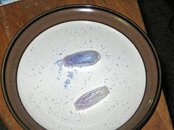- Messages
- 54,470
- Reaction score
- 8,576
- # of dives
- 500 - 999
Well, two cautions....Thanx to you guys at Scuba board! This is my first post however I've been reading the posts on this board for some time now and have learned alot. This peticular post I read some months ago and thought I'ld give it a try with a twist. I couldn't find the damprid at the home depot however I did find it at Walmart. I cut a sponge about 1 inch thick and stuck it in the bottom of a mason jar and then poured the damprid on top.( the pouch will yeild two jars ) Next I buried the moisture munchers in the damprid and left some on top. Within a couple of days they were a deep blue almost purple, beautiful!!! The mason jar seals the air from getting in allowing the damprid to do a faster job and fits nicely with my dive gear to take with me to the dive site, something you can't do with the oven. lol. Also with all that water around the container is safe from water getting in and wrecking all your hard work!!!
.
1: Someone mentioned earlier in this thread that the color indicators may change faster in dehydration than the actual silica gel so you get a false indicator at first in that stage. Best to leave them for a week - more of an after-trip exercise, altho I haven't worried about it. I have kept them all together and used them without care in that regard, but probly best to keep the dehydrating ones seperate.
2: No way do I want to travel with a glass jar, especially on a boat. I might use a plastic jar that formerly contained a food product. Sometimes the Mason lids fit.
Nice to see you posting. 1: Someone mentioned earlier in this thread that the color indicators may change faster in dehydration than the actual silica gel so you get a false indicator at first in that stage. Best to leave them for a week - more of an after-trip exercise, altho I haven't worried about it. I have kept them all together and used them without care in that regard, but probly best to keep the dehydrating ones seperate.
2: No way do I want to travel with a glass jar, especially on a boat. I might use a plastic jar that formerly contained a food product. Sometimes the Mason lids fit.

This $1/each trick is not that big of a deal, but why not eh? I kinda feel like this is my home thread.






